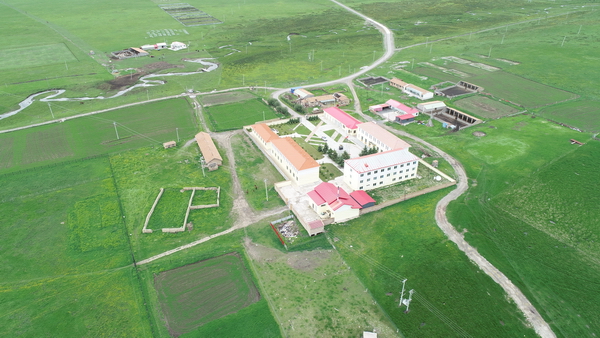
The national field observation station of Haibei Alpine Meadow Ecosystem Research Station in Qinghai province (Haibei Station) was founded in 1976 by Northwest Plateau Institute of Biology, the Chinese Academy of Sciences (CAS). It was located in the northeast of Tibet in a large valley surrounded by the Qilian Mountains at latitude 37°29' - 37°45'N and longitude 101°12' - 101°23'E. The average altitude of the mountain area is 4000 m, and 2900 – 3500 m for the valley area. It is 160 km from Xining City.
It belongs to a typical plateau continental climate which is dominated by the southeast monsoon in summer and high pressure from Siberia in winter. There is no obvious seasonal changes, except only a short cool summer and a long severe cold winter. The annual average air temperature is -1.7℃ with extremes of maximum at 27.6℃ and minimum at -37.1℃. The annual precipitation ranges from 426 mm to 860 mm, 80% of which falls in the growing season from May to September. The annual average sunlight is 2462.7 hours.
The soil types are dominated by Mat Cryic Cambisols (Alpine meadow soil), Mollic Cryic Cambisols (Alpine shrub soil), and Orthic Spodosols (Bog soil). They are underdeveloped gravel soil with a thin layer about 60 – 70 cm and characterized by high organic matter about 12 - 27%, rich in total nitrogen, phosphorus, and potassium but lacking available nutrients. Their parent material is loess and native rock is diluvium and alluvial deposil.
With a typical zonal vegetation of Tibet plateau, the alpine meadow on the sunny slope of mountain and plain areas is dominated by Kobresia humilis, Festuca ovina, and Elymus nulan. The alpine shrub meadow, located on mountain shadow slopes,is dominated by Potentilla fruticosa joined by Kobresia humilis, Festuca ovina, and Elymus nulan. The marsh vegetation distribution to depression consists primarily of Kobresia tibetica and Pedicularis longiflora. Their plant communities have features of simple structure, short growth period, few species, and low primary production.
The Tibetan sheep and yaks are the most important domesticated herbivorous animals in the region.
Haibei Research Station has become one of the open stations of Chinese Ecosystem Research Network (CERN) since 1989, and one of the key stations of CERN since 1992. Moreover, it has become one of the field observation and testing stations of State Department of Science and Technology in China since 2001 and become a formal member in 2006. It is now a national and international important research base on alpine terrestrial ecosystem.
Research Objectives
Surrounding the state requirement on ecological security of Qinghai-Tibet Plateau and the important scientific problems in regional social economical development on the national strategy of the Great Development for the West, it is to provide scientific bases and key technologies to ensure the ecological security and regional sustainable development of Qinghai-Tibet Plateau.
Major Research Tasks
As a research platform for alpine ecology, Haibei Station has three main tasks:
◇ Long–term monitoring
Long–term monitoring is one of the important tasks of Haibei Station. According to the demand and operation standard of CERN, Haibei Station has established long-term monitoring plots for 25 years, where and scientists in meteorology, biology, soil and hydrology work together simultaneously and have obtained lots of observation data about alpine meadow ecosystem. It will offer scientific bases for national or local governments to make regional development policy.
◇ Demonstration
New technologies and methods, which are favorable to alpine regions will be introduced, verified, and investigated. The results can be generalized and popularized to Tibet Plateau. It will raise the scientific and educational level of the farmers and herdsmen of the area and promote regional sustainable economy development.
◇ Research
Focusing on the increasingly worsened ecological environment and surrounding the important national demand of the realization of ecological security on Qinghai-Tibet Plateau, some important researches have been carried out including Qinghai-Tibet Plateau’s formation, evolution and its effect of environment and resources; biological adaptation and evolution under extreme environments; and the restoration and rebuilding of degraded ecosystems and protection of biological resources.
Through the 20 years’ efforts, a multidisciplinary research team has been formed including meteorology, soil, animal-behavior, livestock nutrition, microbiology, plant physiology, plant ecology, and so on. For the further research demands, Haibei Station is developing some new research fields such as productivity ecology, molecular ecology, and ecosystem management.
Established and Ongoing Database
◇ Directory of plant species at the Haibei Station
◇ Database of weather at the Haibei Station
◇ Database of soil monitoring at the Haibei Station
◇ Database of soil moisture and upper water quality at the Haibei Station
◇ Database of plant primary production at the Haibei Station
Data Being Collected
◇ Database of hydro-heat and carbon fluxes of the alpine meadow ecosystem
◇ Database of soil moisture dynamics of the alpine meadow ecosystem
